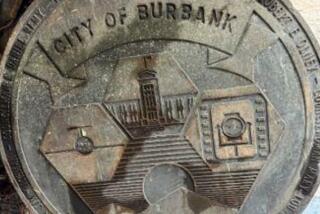Wire Theft Can Be Lucrative and Dangerous
When Lancaster sheriffâs deputies responded to a report of a lifeless man at the base of a roadside utility pole in June, two clues stood out: Burns on the dead manâs hands and a pair of wire cutters nearby.
As the deputies correctly surmised, Thomas Michael Charles, 39, of Lancaster, had been electrocuted while trying to steal copper wire from an electric line.
âItâs fairly common, Iâm told. These guys will go up there to steal the cable wire and then sell it,â said Det. Steve Davis of the Los Angeles County Sheriffâs Department. âItâs a lot of risk for a small reward.â
Still, itâs a risk that hundreds take each year in Los Angeles County alone.
Although a downturn in the scrap metal market had led to a reduction of thefts in recent years, the pilfering of copper and occasionally aluminum wire from utility poles, underground cables, construction sites and off the back of trucks presents an ongoing problem for businesses and law enforcement.
In a typical year, Los Angeles businesses lose about $700,000 to metal theft, authorities said. Countywide the numbers are higher, with many thefts occurring in desert areas where wire materials are plentiful and there are fewer potential witnesses.
Law enforcement officials say that metal thefts can range from one person with a pair of wire cutters snipping a few feet of cable to organized teams of thieves who use heavy winches and trucks to remove and transport hauls weighing thousands of pounds.
Don Drissel, manager of investigations for Southern California Edison, said that with scrap copper currently selling for only 50 to 60 cents per pound--down from a high of about $1.10 per pound in the early 1990s--metal theft has decreased almost 50%.
âWhen the cost is high, we have somewhere between 40 to 50 reported thefts per year,â Drissel said. âIâve been with the company 20 years and metal theft has always been a problem. . . . It happens all over the country and worldwide.â
A recent case involved Indiana Plumbing Co. in Van Nuys. Thieves made off with 8,000 pounds of copper tubing that was left overnight on pallets in the companyâs back lot. Company officials estimated that the haul was worth nearly $5,000.
The California Metal Investigators Assn., which includes law enforcement and security agencies from utilities, aerospace companies and other businesses, holds monthly meetings to discuss how to guard against getting ripped off and how best to pursue metal thieves.
Some of the larger companies, including Edison, have begun to mark their wire, making it easier for investigators like Det. Thomas Mann of the Los Angeles Police Department to identify stolen property in scrap yards and follow the paper trail back to the thieves.
Without the markings, Mann said, wire theft can be almost impossible to trace.
âThe scrap yards will inquire about where the cable comes from but usually [the thieves] will just say âitâs leftover from a job and my boss gave it to me,ââ Mann said.
âIf itâs heavy stuff, and you can get away, itâs quite a good profit,â Mann said.
But at what cost?
Although fatal accidents like the one that claimed the life of Charles are rare, authorities say, injuries are not uncommon among would-be wire thieves.
Cable wire ranges in thickness from that of a pencil lead to a manâs thumb and can carry up to 6,000 volts of electricity.
âWeâve had some cases where some guys have been burned pretty bad,â said Mann. âIt happens occasionally. Someone will try to cut a line or yank some cable out of the ground and they wonât realize there is a current running through it.â
More to Read
Sign up for Essential California
The most important California stories and recommendations in your inbox every morning.
You may occasionally receive promotional content from the Los Angeles Times.










